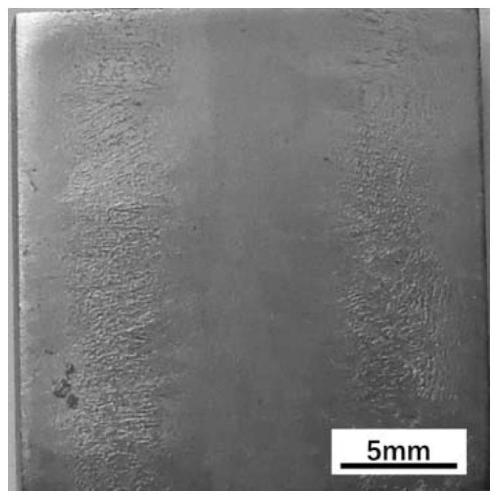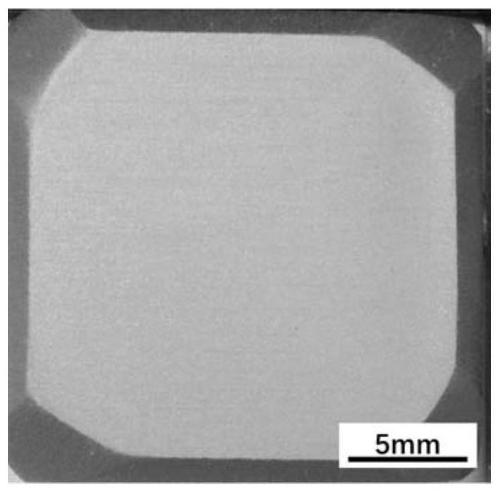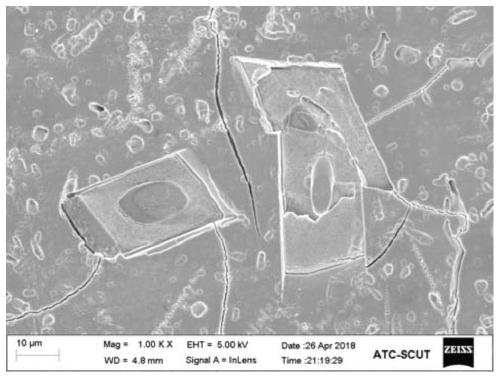Anodizable Al-Mn series cast aluminum alloy and anodizing process thereof
A technology of casting aluminum alloy and anodizing, applied in the field of aluminum alloy, can solve the problems of difficult dyeing process, uneven color, rough surface of anodized film, etc., and achieves the effect of easy control of adding amount, uniform color and improved mechanical properties
- Summary
- Abstract
- Description
- Claims
- Application Information
AI Technical Summary
Problems solved by technology
Method used
Image
Examples
Embodiment 1
[0045] In this example, on the basis of comparative examples, the composition of the Al-2Mn alloy is controlled, and the raw materials used for the control include: Al-10Mn master alloy, Al-10Co master alloy, Al-2Sc master alloy and Al-10Ti master alloy. First heat the pure aluminum to 780°C, keep it warm for 3 hours to make it completely melt, add the intermediate alloy according to the proportion, then increase the temperature of the resistance furnace to 850°C and keep it warm for 30 minutes, and stir the metal solution every 10 minutes during the heat preservation period to ensure The added master alloy can be fully melted. Then the melt is degassed, impurity-removed, refined and slag-pulled, and left to stand for 5 minutes before being cast out of the furnace. The molten metal was poured into a mold at 200° C. for cooling to obtain the alloy of Example 1. The composition and mass percentage of the alloy are: Mn: 2%, Co: 1%, Sc: 0.3%, Ti: 0.2%, and the balance is Al.
[...
Embodiment 2
[0052] In this example, on the basis of comparative examples, the composition of the Al-2Mn alloy is controlled, and the raw materials used for the control include: Al-10Mn master alloy, Al-10Co master alloy, Al-2Sc master alloy and Al-10Ti master alloy. First heat the pure aluminum to 780°C, keep it warm for 3 hours to make it completely melt, add the intermediate alloy according to the proportion, then increase the temperature of the resistance furnace to 850°C and keep it warm for 30 minutes, and stir the metal solution every 10 minutes during the heat preservation period to ensure The added master alloy can be fully melted. Then the melt is degassed, impurity-removed, refined and slag-pulled, and then left to stand for 2 minutes before being cast out of the furnace. The molten metal was poured into a mold at 200°C for cooling to obtain the alloy of Example 2. The composition and mass percentage of the alloy are: Mn: 2%, Co: 0.7%, Sc: 0.2%, Ti: 0.3%, and the balance is Al....
Embodiment 3
[0057] In this example, on the basis of comparative examples, the composition of the Al-2Mn alloy is controlled, and the raw materials used for the control include: Al-10Mn master alloy, Al-10Co master alloy, Al-2Sc master alloy and Al-10Ti master alloy. First heat the pure aluminum to 780°C, keep it warm for 3 hours to make it completely melt, add the intermediate alloy according to the proportion, then increase the temperature of the resistance furnace to 850°C and keep it warm for 30 minutes, and stir the metal solution every 10 minutes during the heat preservation period to ensure The added master alloy can be fully melted. Then the melt is degassed, impurity-removed, refined and slag-pulled, and then left to stand for 4 minutes before being cast out of the furnace. The molten metal was poured into a mold at 200°C for cooling to obtain the alloy of Example 3. The composition and mass percentage of the alloy are: Mn: 2%, Co: 1.2%, Sc: 0.4%, Ti: 0.1%, and the balance is Al....
PUM
| Property | Measurement | Unit |
|---|---|---|
| concentration | aaaaa | aaaaa |
| tensile strength | aaaaa | aaaaa |
| current density | aaaaa | aaaaa |
Abstract
Description
Claims
Application Information
 Login to View More
Login to View More - R&D
- Intellectual Property
- Life Sciences
- Materials
- Tech Scout
- Unparalleled Data Quality
- Higher Quality Content
- 60% Fewer Hallucinations
Browse by: Latest US Patents, China's latest patents, Technical Efficacy Thesaurus, Application Domain, Technology Topic, Popular Technical Reports.
© 2025 PatSnap. All rights reserved.Legal|Privacy policy|Modern Slavery Act Transparency Statement|Sitemap|About US| Contact US: help@patsnap.com



